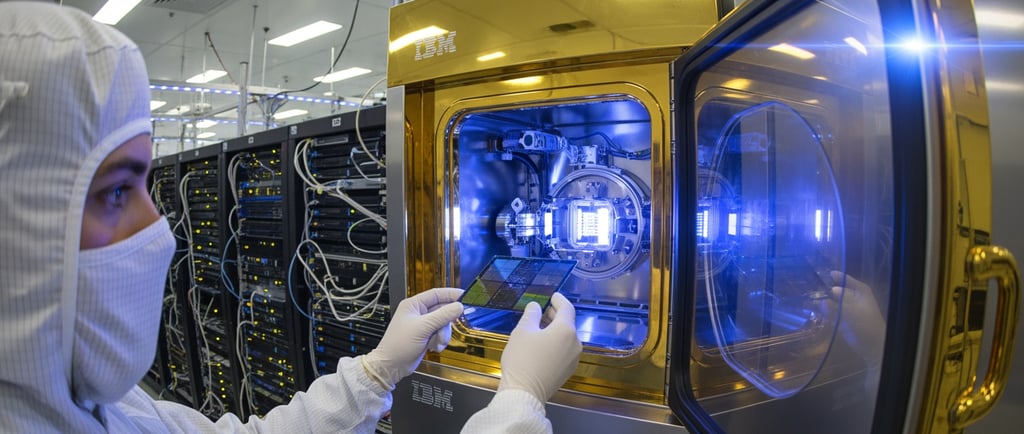"IBM Unleashes Quantum Nighthawk & Loon Chips: 120-Qubit Power Play Targets 2029 Fault-Tolerance"
IBM storms back into the quantum race with two fresh chips—Nighthawk boosts gate depth to 5,000, while Loon packs every error-correction gadget needed for a fault-tolerant future.
NANO CHIPCULTURE


IBM Charges Back into the Quantum Race with Two New Processors
The quantum spotlight swung back to IBM on 12 November 2025 as the company unveiled a dual-chip offensive designed to reclaim leadership in the race for useful quantum computing. Codenamed Nighthawk and Loon, the processors target two different milestones: immediate “quantum advantage” demonstrations by 2026 and full fault-tolerant machines by 2029.
1. Nighthawk: 120 Qubits, 30% More Complex Circuits
Built around a square lattice of 120 superconducting qubits, IBM Quantum Nighthawk introduces 218 next-generation tunable couplers—over 20% more than its predecessor Heron—allowing each qubit to talk to four nearest neighbours with lower crosstalk. The denser connectivity pushes achievable circuit depth to 5,000 two-qubit gates today, with a roadmap to 7,500 gates by the end of 2026 and 10,000 gates in 2027. IBM says the extra headroom increases executable algorithmic complexity by roughly 30% while maintaining two-qubit gate fidelities above 99.9% for more than half of all qubit pairs tested, a key threshold for beating classical solvers on selected optimisation and chemistry problems.
2. Loon: The 112-Qubit Blueprint for Fault-Tolerance
Where Nighthawk scales width, IBM Quantum Loon scales depth—not in gates per circuit but in error-correction architecture. The 112-qubit device sports six-way couplers, extra metal routing layers and on-chip “reset gadgets” that can return a qubit to its ground state in nanoseconds. According to IBM, Loon is the first processor to integrate every hardware component required for quantum error-correction (QEC) using the company’s preferred qLDPC code family. In parallel, engineers demonstrated real-time decoding of errors in <480 ns, beating their own 2026 target by a full year and proving that classical co-processors can keep pace with superconducting time scales.
3. Why Two Chips Instead of One?
Jay Gambetta, IBM Research Director, framed Nighthawk and Loon as complementary “short- and long-term levers.” Nighthawk will land in the public cloud before year-end 2025, giving scientists a bigger playground for near-term algorithms such as variational quantum eigensolvers and quantum machine-learning kernels. Loon, still in the lab, will guide fabrication tweaks needed for a 1,000-qubit, 15,000-gate system by 2028 and ultimately a fault-tolerant data-center rack by 2029. The split mirrors IBM’s new mantra: scale qubits and scale correction in parallel rather than waiting for perfect qubits to appear.
4. 300 mm Fabs Enter the Quantum Era
To hit those dates IBM moved its wafer line from the research clean-room to the Albany NanoTech Complex, a 300 mm semiconductor facility in New York. Automated steppers and multi-layer lithography cut processor build times in half and, according to the company, deliver a ten-fold jump in physical complexity without sacrificing yield. The same node will be used for both Nighthawk follow-ups and the larger Loon descendants, ensuring packaging techniques like low-loss wiring and cryo-CMOS control chips can evolve alongside qubit count.
5. Software Stack Gets a C++ Turbo-Inject
Hardware is only half the story. A refreshed Qiskit SDK adds a C++ execution layer and high-performance error-mitigation routines that boost circuit layer operations per second (CLOPS) to 330,000—65% faster than 2024 levels. IBM also released a community “quantum-advantage tracker,” inviting third parties to submit workloads and classical baselines. Early candidates from Algorithmiq and the Flatiron Institute focus on observable estimation and constrained optimisation, two areas where Nighthawk’s extra gate depth may first outrun the best conventional algorithms.
6. What It Means for Industry watchers
With Google touting its Willow chip and Quantinuum shipping Helios, IBM’s twin-announcement signals it has no intention of ceding ground. If Nighthawk hits the promised 7,500-gate mark next year, clients in finance, logistics and materials science could finally see end-to-end runtime advantages on real use-cases rather than toy problems. More importantly, Loon shows a credible path to error-corrected machines before the decade closes, a milestone that would upend cryptography, drug discovery and precise scheduling markets that hinge on exponentially hard optimisation.
7. The Bottom Line
After a relatively quiet 2024 on the hardware front, IBM roared back with two processors that attack the quantum challenge from opposite flanks: Nighthawk widens the near-term pipeline, Loon hardens the long-term foundation. Whether the gambit pays off will depend on meeting aggressive gate-depth targets and keeping error rates from ballooning as circuits grow, but for now Big Blue has placed itself squarely at the centre of the next phase of the quantum race.
Sources
Live Science – IBM unveils two new quantum processors
Reuters – IBM says Loon chip shows path to useful quantum computers by 2029
Tom’s Hardware – IBM unveils new 120-qubit Nighthawk processor
The Quantum Insider – IBM reveals new quantum processors, software and algorithm advances
Constellation Research – IBM launches IBM Quantum Nighthawk processor
Nextgov – IBM unveils updated quantum computing products


